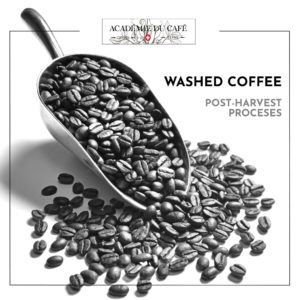
WASHED COFFEE
Historically, this process was developed recently while the historical or original drying process is the natural or dry process. In commercial coffees, the washed ones have more value than the natural ones.
The « washed » process, also known as the wet process, is a method of processing coffee cherries to prepare them for roasting. Colombia, Central America and East African countries are the most common locations where this post-harvest process occurs. This process is highly regarded for its ability to produce a clean cup, bright acidity and consistent flavor profile. Here’s a detailed description of this post-harvest process:
Harvesting: The process begins with the careful selection and harvesting of ripe coffee cherries. Only the reddest, ripest cherries are picked, as they contain the sweetest and most flavorful beans. Selection of ripe cherries is a critical step for quality !
Depulping: Once harvested, the outer skin of the cherries is removed, usually on the same day of picking, to avoid fermentation and spoilage. This is done using a depulping machine, which mechanically squeezes the cherries to push the beans out while leaving the skin behind.
Fermentation: The depulped beans, still covered with mucilage (a sticky, pectin based substance), are then placed in fermentation tanks. This stage is crucial as it affects the final flavor of the coffee. Fermentation typically lasts between 12 to 48 hours, depending on the climate and altitude. During this time, natural or addition of external enzymes break down the mucilage.
Washing: After fermentation, the beans are washed with large quantities of water to remove the mucilage residue. This step is important for stopping the fermentation process and for ensuring that the beans don’t develop unwanted sour flavors.
Drying: The washed beans are then spread out in thin layers on raised beds, patios to dry under the sun. This can take several days, and the beans need to be regularly turned to ensure even drying. The goal is to reduce the moisture content to about 10-12%. In some cases, mechanical dryers are used, especially in regions with less predictable weather.
Resting: Once dried, the beans, now in a form called « parchment coffee » or “pergamino” due to the dry, paper-like husk surrounding them, are stored and rested for several weeks. This resting period allows the beans to develop a more stable flavor profile.
Hulling: The final step before the beans are ready for export or roasting is hulling. This process removes the dried husk or parchment from the beans.
The washed process is favored for its ability to produce coffee with brighter acidity and cleaner, more distinct flavors compared to other methods like the natural or honey processes. However, it requires a significant amount of water and can be more labor-intensive, which are important considerations in terms of environmental impact and cost.